History of the Great Black Swamp
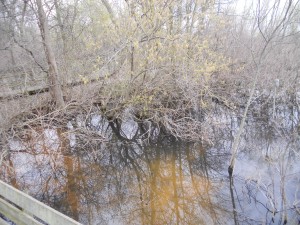
Some areas of the Great Black Swamp would have water waist high. The swamp water at Magee Marsh near Oak Harbor, Ohio isn't nearly that deep. Photo by Kaycee Hallett
Some 20,000 years ago Northwest Ohio was covered by glaciers. These glaciers melted and formed the Great Lakes. But the Great Lakes aren’t the only features left behind by the prehistoric glaciers.
One of the largest natural wetlands in Ohio was once in this area and now it is almost completely gone. Wetlands are an important feature in the environments in any ecosystem. Wetlands help to stop erosion and drainage into the lakes.
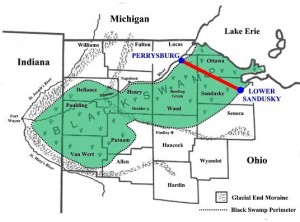
Historic Map of the Great Black Swamp. Created by Gary L. Franks for "The Maumee & Western Reserve Road: Its History and a Survey of the Milestones" published in 2008.
A great swamp left by the retreating glaciers covered a huge area of land going as far east as present-day Sandusky, Ohio as far south as Findlay, Ohio, and as far west as Fort Wayne, Indiana. It was a nearly impenetrable area of thick trees and murky water that sometimes was as deep as chest high.
The area was known as the Great Black Swamp and remnants of it can still be seen today.
If the Great Black Swamp was still more prominently present in Ohio the problem with agricultural runoff wouldn’t actually be as prevalent. Right now when there are heavy rains, or if fertilizer is not mixed into the soil properly, the nitrate and phosphorus rich soil drain into the rivers which in turn drains into Lake Erie.
The extra nutrients cause algae to bloom and when that algae dies and sinks to the bottom the bacteria that breaks it down uses up so much oxygen that life is no longer sustainable in that area. This is called hypoxia.

Remnants of the Great Black Swamp can be seen at Magee Marsh, a few miles outside of Oak Harbor, Ohio. Photo by Kaycee Hallett
The destruction of the wetlands is not something specific to the Great Black Swamp, but because of its destruction according to the Environmental Protection Agency, Ohio has lost 90% of its wetlands. This is second only to California which has lost 91%.Direct problems associated with the loss of the wetlands include more flood damages, more drought damages, and a decline in the bird population.
“The lake bed sediments are a lot of silt and clay, primarily clay, and water cannot move easily through that. So when the lake sank down to its present size, it left an area that could not drain very well. So water built up in it and it became a swamp,” said Associate Professor Sheila Roberts, a professor of geology at Bowling Green State University
The Great Black Swamp held many natural resources, good soil and lots of timber, but for years there wasn’t a way for settlers to get at them.
“They would finally get a road wide enough for maybe a wagon to go down, but if one person was coming from the north and another person was coming from the south somebody would have to get off into the swamp and let the other people pass, and they were constantly digging out horses and wagons and everything,” Roberts said.
While the Great Black Swamp put the settlement of Northwest Ohio on hold for the settlers of the time, some of the Native American tribes of the area were forced to live there, specifically the Ottawa tribe.
After a long history of dealing with the settlers as trading partners and allies in war, the Ottawa land was shuffled around and after signing the Treaty of Grenville in 1796 the white settlers pushed into the interior of Ohio and it quickly became a state. The Ottawa Indians were pushed to the Maumee River Valley at the edge of the Great Black Swamp.
While the Ottawa Indians lived only on the edge of the Great Black Swamp they did use the swamp for resources. They hunted in the swamp, something many white settlers would not do. The Ottawa’s overcame this by staying on sand ridges while hunting. These elevated areas of land were prehistoric beaches, formed while the glacial lake receded into the modern Lake Erie.
“They would follow the game in there, but they wouldn’t live in there because it was too mosquito infested,” said Danziger.
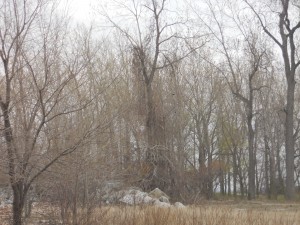
The Great Black Swamp was very tree-rich and these trees here are small in comparison with those that stood in the swamp. Photo by Kaycee Hallett
The Ottawa Indians overcame their bug problem in several ways. Their housing had a hole cut in the top and a fire that could be lit on the inside. The smoke would keep away insects. They also concocted an insect repelling rub. They did their hunting in the winter months where the insects were less prevalent and wore long sleeves.
The Ottawa Indians began to forfeit their culture comply with the desires of their white neighbors. They began farming corn and wearing clothing similar to the white settlers, but it wasn’t enough for those settlers greedy for land on the Ottawa reservations.
The Ottawa Indians reservations were in the way of the proposed canal system and they were removed.
“They were doing exactly what American settlers wanted them to do and they were still forced to go,” said Danziger
By 1833 the Ottawa’s were relocated to Kansas.
Travel before the swamp was drained forced settlers had to detour south into the more central part of Ohio and were unable to head north again until around Fort Wayne, Indiana. The Great Black Swamp covered a huge area of land and draining the swamp would have been an extremely daunting task.
The idea of draining the swamp began with the construction of a road going from Fremont, Ohio to Detroit, Michigan through the heart of the Great Black Swamp. There was a lot of difficulty building a road through the swamp that wouldn’t get washed away by the natural movement of the water. Finally the constructors built a road leveled with rock underneath so it was higher than the surrounding land. They dug two ditches, one on either side of the road, and on top of that they dug culverts. The culverts were dug underneath the road to channel the water and enable it to go in its natural selection.
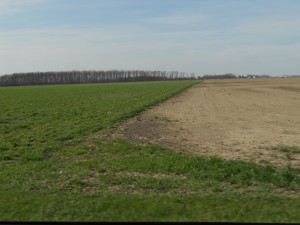
Today the majority of land that used to be the Great Black Swamp is used for agriculture. Photo by Kaycee Hallett
Draining a small area of the swamp and the workers discovered that the soil underneath the water was very fertile. This led to the widespread draining of the Great Black Swamp starting in the 1850’s.
Draining the swamp was not the only thing that needed done in order to get at the rich soil. Since the Great Black Swamp was such a tree rich swamp, the trees also had to go. Timber had become a very useful and sought after commodity, one that was now easy to transport thanks to the canals running from Lake Erie to New York, the canals that cost the Ottawa Indians their land. Oak trees were especially plentiful in the swamp and were in demand worldwide.
“It was basically used for ship’s timbers, and they floated it out on rafts of wood all the way to Buffalo down the Erie Canal and all the way to England,” Danziger said.
“If you look at all the drainage ditches we have around here now, and digging those with the technology they had, it was quite a feat,” Roberts said.

A drainage ditch runs along farmlands, these are necessary to prevent flooding in the area. Photo by Kaycee Hallett
There are still some ways to see the remains of the Great Black Swamp now, even with the drainage ditches. This area is prone to flooding due to the clay that is still in the soil.
“After a big rainstorm, or when the snow starts to melt, you’ll notice there’s water ‘ponded’ in them [fields] and that’s because the water can’t seep into the ground because it’s so impermeable,” Roberts said.
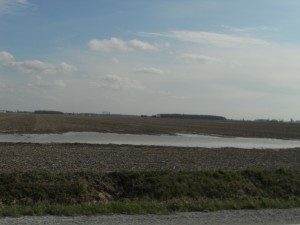
A flooded farm in the spring shows is a common sight in Northwest Ohio thanks to the Great Black Swamp. Photo by Kaycee Hallett
Flooding isn’t the only way to see some of the features of the Great Black Swamp. There are a few state parks that preserved what the Great Black Swamp would have looked like. Crane Creek and Magee Marsh near Oak Harbor, Ohio, are two such areas. Even here in Bowling Green, Ohio there are some attributes from the drained swamp such as the Sand Ridges in the Cemetery located on Bowling Green State University campus and on Sand Ridge Road.
State and national governments are beginning to allot money into expanding and replanting some of these wetland areas lost in draining the swamp, in hopes that this will help reduce the harmful agricultural runoff, that would have prevented had the swamp been preserved.